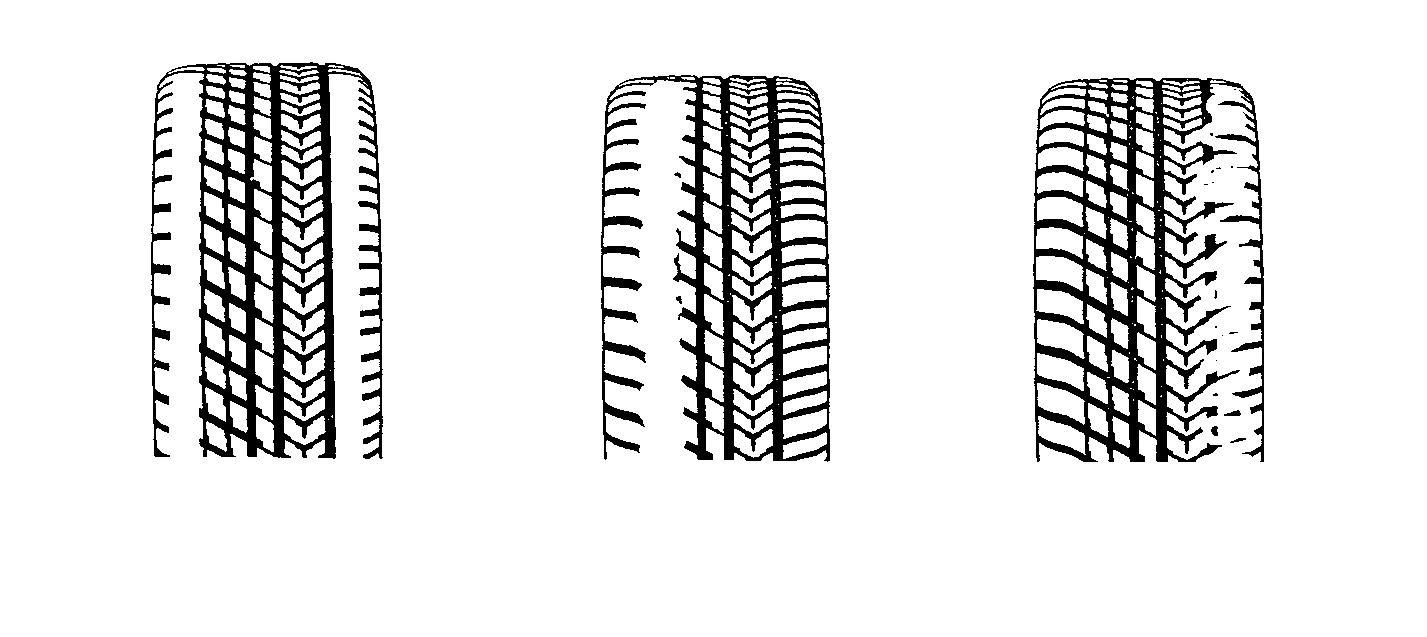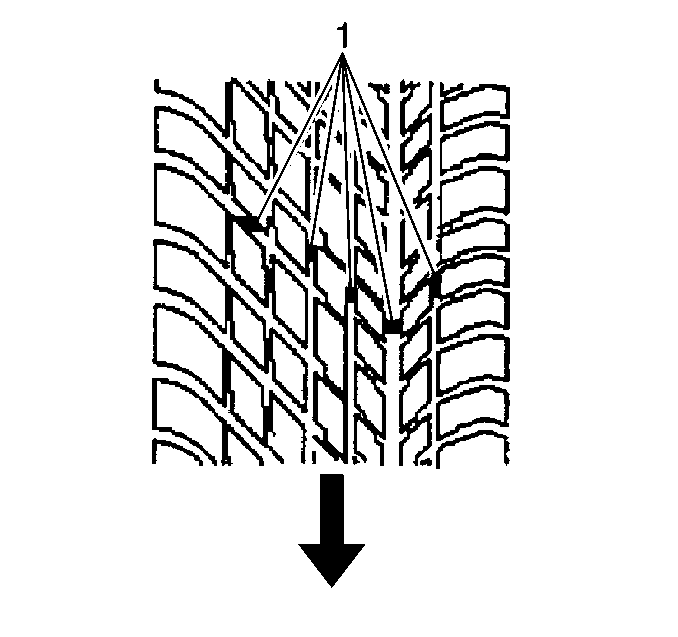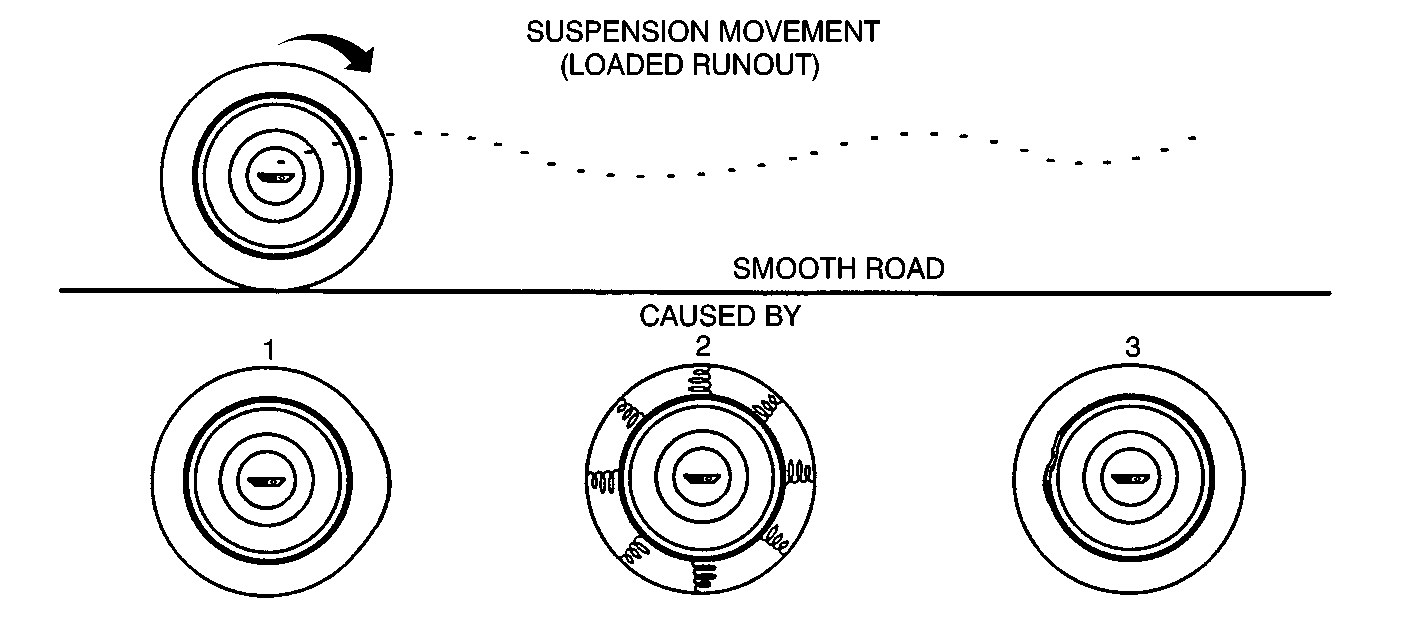Irregular and/or Premature Wear

The following are some causes for irregular and premature wear:
| • | An incorrect tire inflation pressure. |
| • | A lack of tire rotation. |
| • | Harsh driving habits. |
| • | An incorrect wheel alignment. |
| • | A faulty tire (radial belts). |
| • | A damaged shock. |
| • | A worn shock. |
| • | An unbalanced tire. |
| • | A damaged wheel. |
| • | A damaged rotor. |
| • | A damaged axle shaft. |
| • | A worn rotor. |
| • | A worn axle shaft. |
Inspection Procedure
Rotate the tire and wheel if the following conditions are noted:
| • | The front tire wear is different from the rear tire wear. |
| • | An uneven wear exists across the tread of any tire. |
| • | The left front and the right front tire wear is unequal. |
| • | The left rear and the right rear tire wear is unequal. |
Check the wheel alignment check if the following conditions are noted:
| • | The left and the right front tire wear is irregular. |
| • | The wear is uneven across the tread of any front tire. |
| • | The front tire treads have a scuffed appearance with feathered edges on one side of the tread ribs or the blocks. |
Tread Wear Indicators

Built-in tread wear indicators are equipped on the original tires. The built-in tread wear indicators show when tires need replacement. The indicators appear in 6 places (every 60) around the tire when the tread is worn to 2/32 inch . Tire replacement is recommended when the indicators appear in 3 or more locations.
Radial Tire Waddle

Waddle is a side to side movement at the front and/or at the rear of the vehicle. A steel belt not being straight within the tire can cause a waddle. A waddle is most noticeable at low speeds of 8-48 km/h (5-30 mph). A waddle may appear as a ride roughness at speeds of 80-113 km/h (50-70 mph). Road test the vehicle to see which end of the vehicle has the faulty tire. A rear waddle tire causes the rear of the vehicle to shake from side to side or to waddle. From the driver's seat it feels like someone is pushing on the side of the vehicle. The front hood assembly appears to move back and forth in a front waddle tire. The driver feels as though he is at the pivot point. Use a Tire Problem Detector (TPD) to detect a waddle. The TPD is a roller drum that slowly rotates the tire on the vehicle while under load (checking the spindle vibration). The following common method is often used to determine the faulty tire by substituting a known good tire/wheel assembly:
- Road test the vehicle to determine if the waddle is coming from the front or the rear.
- Road test the vehicle again.
- If improvement is noted install the original tire and wheel assemblies one at a time until the faulty tire is found.
Install tire and wheel assemblies known to be good (on similar vehicle) if the place of those on the offending end.
Important: Refer to if the vehicle is equipped with the Tire Pressure Monitoring System (TPMS).
Radial Tire Lead/Pull
Lead Pull is the deviation from a straight path on a level road with no pressure on the steering wheel. The following are common causes of Lead Pull:
| • | Tire construction. |
| • | Uneven brake adjustment. |
| • | Wheel alignment. |
The way in which a tire is built can produce lead. An example if the placement of the belt. An off center belt on radial tires causes the tire to develop a side force while rolling straight down the road. The tire tends to roll like a cone. Use the Radial Tire Lead/Pull Correction chart to make sure that the wheel alignment is not mistaken for tire lead. Rear tires usually do not cause lead/pull.
Vibrations: Tire, Hub And Axle Related

Imbalance or runout can cause tire or wheel induced vibrations.
Low-speed vibrations (those less than 40 mph) usually are runout related. Highway speed vibrations (those above 40 mph) can be caused by either imbalance or runout.
Test Description
The numbers below refer to the numbers in the VIBRATION COMPLAINT CHART.
- Road test the vehicle to verify the complaint.
- Perform a careful visual inspection for the following:
- Perform a balance procedure if vibrations occur at high speeds. A balance procedure is the easiest procedure to perform. Perform an off-car two-plane dynamic balance first. An off-car two-plane dynamic balance will correct any imbalance in the tire and wheel assembly. If the off-car two-plane dynamic balance does not correct the highway speed vibration, the probable cause is excessive runout. The following can cause runout:
- Runout is the probable cause of low speed vibrations. Measure the free runout of the tire and wheel assembly. Use a dial indicator with a roller wheel if available. A dial indicator with a button end may be used. Measure lateral runout (side to side) on the tire's sidewall as close to the read shoulder as possible. Measure radial runout (up and down) on the center tread rib. Some tread designs require tightly wrapping a piece of tap around the center tread circumference for a better dial indicator contact. Refer to to measure wheel runout. Disregard any instantaneous indicator needle jumps due to sidewall depressions, tread block, etc. when measuring radial and lateral runout. Record total indicator reading. Record the location of the high point of the runout. The total tire and wheel on-car runout should be less than 1.5 mm (0.060 in). Go to Step 5 if either measurement exceeds 1.5 mm (0.060 in).
- Mount the tire and wheel assembly on a dynamic balance machine. Measure the amount of runout. Locate on the machine by the wheels inside the center pilot hole. Use the same procedure as in Step 4 to record the amount of tire runout and its high point location. Refer to Replace the wheel if it exceeds specifications. If the tire and wheel radial runout or the tire and wheel lateral runout exceeds 1.27 mm (0.050 in) at the tire tread perform the following procedure:
- The attachment of the tire and wheel assembly to the hub is the probable cause if the runout of the tire and wheel assembly is within limits when measured off the car, but exceeds the limits when measured off the car. Rotate the tire and wheel assembly two wheel studs. Recheck the runout. Several positions may have to be tried to find the best location. Proceed to Step 7 if the tire and wheel assembly runout cannot be reduced to an acceptable level.
- Remove the tire and wheel assembly. Use a dial indicator to measure the wheel stud runout. Zero the dial indicator button on one stud. Lift button gently off stud. Rotate the flange to position next stud against the dial indicator button. Record the runout on all studs. The dial indicator should read zero when repositioned on the first stud that was checked. Replace the hub if the runout exceeds 0.76 mm (0.030 in).
- An on-vehicle finish balance may be required. An on-vehicle finish balance will correct any imbalance in the tire and wheel assembly. An on-vehicle finish balance will correct any brake rotor imbalance. An on-vehicle finish balance will correct any hub cap imbalance.
| • | Inspect for obvious tire and wheel runout. |
| • | Inspect for obvious drive axle or propeller shaft runout. |
| • | Inspect for proper inflation pressure. |
| • | Inspect for wrong trim height. |
| • | Inspect for bent wheels. |
| • | Inspect for debris build-up on the tire or wheel. |
| • | Inspect for loose or missing wheel weights or wheel nuts. |
| • | Inspect for irregular or excessive tire wear. |
| • | Inspect for proper tire bead seating on the rim. |
| • | Inspect for the following for tire damage: |
| • | Inspect for tread distortions. |
| • | Inspect for tread separations. |
| • | Inspect for tread bulges from impact damage. Slight sidewall indentations are normal. Slight sidewall indentations do not affect the ride quality. |
| • | The tire can cause runout. |
| • | The wheel can cause runout. |
| • | The way the wheel attaches to the car can cause runout. |
| 5.1. | Break down the tire and wheel assembly. |
| 5.2. | Rotate the tire on the rim 180 degrees. |
| 5.3. | Refer to if the vehicle is equipped with TPMS. |
| 5.4. | Reinflate the tire. |
| 5.5. | Mount the tire on the dynamic balance machine. |
| 5.6. | Measure and record the radial and the lateral runout and its location. |
| 5.7. | Replace the tire if the following conditions exists: |
| • | If the radial runout still exceeds 1.27 mm (0.050 in). |
| • | If the lateral runout still exceeds 1.27 mm (0.050 in). |
| • | And if the high point has moved approximately 180 degrees (following the tire around the rim). |
| 5.8. | Rotating the tire in many cases will bring the assembly into the acceptable range of less than 1.27 mm (0.050 in). |
Step | Action | Value(s) | Yes | No |
|---|---|---|---|---|
1 | Road test the vehicle to verify complaint. Is vibration present? | -- | -- | |
2 | Visually inspect the wheels and the tires for debris or road damage Are the wheels free of debris and road damage? | -- | ||
3 |
Is repair complete? | -- | System OK | -- |
4 | Is vibration present at high speed? | Above 64 km/h (40 mph) | ||
5 | Perform off vehicle dynamic balance. Is vibration still present? | -- | System OK | |
6 | Is vibration present at low speed? | Below 64 km/h (40 mph) | ||
7 | Perform on vehicle runout check. Is runout excessive? | -- | ||
8 |
Is the vibration still present? | -- | System OK | |
9 | Index assembly on wheel studs. Is vibration still present? | -- | -- | |
10 | Perform on vehicle finish balance. Is vibration still present? | -- | System OK | |
11 | Measure axle or hub flange runout. Is runout excessive? | -- | System OK | |
12 | Replace the axle shaft or replace the hub as necessary. Is the repair complete? | -- | System OK | -- |
Diagnostic Aids
| • | The assembly must be rebalanced under the following conditions: |
| - | Rebalance the assembly if a tire is rotated on the wheel. |
| - | Rebalance the assembly if a tire is replaced. |
| - | Rebalance the assembly if a wheel is replaced. |
| • | Use a Tire Problem Detector (TPD) or loaded radial runout buffer to detect the following causes of vibration: |
| - | Balance runout can cause vibration. |
| - | Tire runout can cause vibration. |
| - | Wheel free runout can cause vibration. |
| - | Tire stiffness variation (loaded radial runout) can cause vibration. |
| • | The TPD is a roller drum that slowly rotates the tire while under load and mounted on the vehicle. Tire stiffness variation causes the wheel spindle movement which can be measured. |
| • | The loaded radial runout buffer is a more automated machine that slowly rotates the tire and wheel off the car under load with a roller drum. The loaded radial runout buffer measures the tire's stiffness variation. The loaded radial runout buffer matches the tire to the wheel by buffing off small amounts of rubber from the outer tread rows at the stiff spot. This procedure is effective as a measuring device and is effective for fine buffing only. |
| • | The TPD and the loaded radial runout buffer methods measure or correct the following at the same time: |
| - | Tire stiffness. |
| - | Tire variation. |
| - | Tire runout. |
| - | Wheel runout. |
| • | The TPD and the loaded radial runout buffer methods are not always available. The TPD and the loaded radial runout buffer methods have their disadvantages. Use the dial indicator to measure free runout for a more practical method. The free runout of the tire will usually correspond with the tire's stiff spot. |
| • | Use the substitution method of vibration diagnosis for an alternative method. Install a known good set of tire and wheel assemblies. If these correct the vibration, reinstall one at a time the original tire and wheel assemblies until the vibration returns. This will point out the tire with excess stiffness variation. |
| • | Tire stiffness variation may be higher or lower depending on the direction of the tire rotations. |
